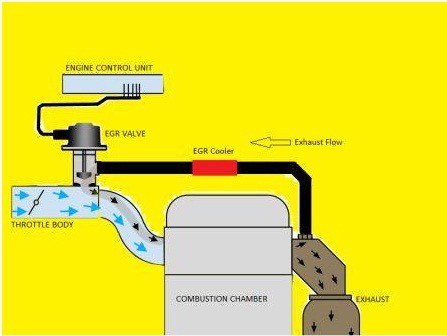Exhaust Gas Recirculation | EGR
Exhaust Gas Recirculation (EGR) is the emission controlling technique majorly used in Diesel Engines. But with the introduction of Bharat Stage 6 Emission Norms which are equivalent to Euro 6 Emission Norms, EGR has also become part of Gasoline Engines. Basically by using the Exhaust Gas Recirculation Technology, we are primarily focusing on reduction of Nitrox (NOX) Emissions.
So what happens is when chemical reaction between Nitrogen and Oxygen takes place, the Nitox Emissions are produces when Engine operates at extreme high temperatures. The Nitrox (NOX) are chemically the Oxides of Nitrogen such as Nitric Oxide (NO), Nitrogen Dioxide (NO2), Nitrous Oxide (N2O) and many more. These are highly poisonous and dangerous gases for living beings and environment. Nitrox also contribute in production of Smog and Acid Rain.
Now next question is How EGR Works? Advertisement
So in order to control the Nitrox Emissions the exhaust gases are circulated again into the engine by mixing it with the Air entering the combustion chamber. The NOX dilutes or basically saying reduces the concentration of Oxygen (O2) in the Inlet Air entering the combustion chamber. Thus the gases are produced which does not support combustion (Nitrogen does not support combustion) and absorbs the heat produced by the combustion process resulting in decreased temperature inside the combustion chamber. As discussed earlier the Nitrox emissions are produced at high temperatures, thus decrease in temperature resulted in lowering of Nitrox Emissions.
Now the point here to remember is that not all the exhaust gases are recirculated but the small portion only.

EGR Working
- EGR Valve: The function of EGR valve is to let exhaust gases mix with inlet air when open. It is basically the Solenoid Actuator which acts on command from Engine Control Unit. When EGR valve is in close position the exhaust gases are not able to mix with inlet air.
- Engine Control Unit (ECU): It is Microcontroller based computer which is used to control various parameters in Engine operation. It takes readings from various sensors and make calculations and gives command to various actuators. In case of EGR, the ECU takes readings from Engine Coolant Temperature Sensor and Exhaust Sensors, and actuator is EGR valve.
- EGR Cooler: It is basically a heat exchanger device which is used to cool down the exhaust gases that are entering the engine cylinder. It is done to prevent further rise in engine temperature due to the hot exhaust gases.
For more updates stay tuned to revjust.com.
-Team Revjust


